We were born before the wind
Also younger than the sun
Ere the bonnie boat was won as we sailed into the mystic
Hark, now hear the sailors cry
Smell the sea and feel the sky
Let your soul and spirit fly into the mystic
And when that fog horn blows I will be coming home
And when the fog horn blows I want to hear it
I don’t have to fear it
And I want to rock your gypsy soul
Just like way back in the days of old
And magnificently we will flow into the mystic
When that fog horn blows you know I will be coming home
And when that fog horn whistle blows I got to hear it
I don’t have to fear it
And I want to rock your gypsy soul
Just like way back in the days of old
And together we will flow into the mystic
Come on girl… ( Van Morrison, Into the Mystic )
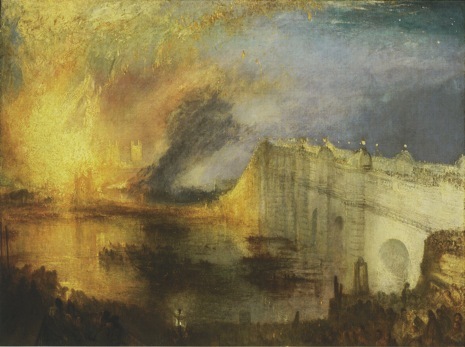
''Hiring a boat, he bobbed back and forth, riding the tide, at Westminster Bridge. There had been no foul play, but, since a Parliamentary-reform act had been passed just two years before, amid loudly voiced fears that, unless it was legislated, the kingdom might, like France in 1830, go down in bloody revolution, the relationship between rulers and ruled was in perilous play. A dominating feature of the two “Burning of the Houses of Lords and Commons” paintings that resulted—one now in Cleveland and one in Philadelphia—is the crowds jamming the embankment and Westminster Bridge, watching, fixedly, the cremation of “Old Corruption.” This is another authentic first—the painting of the People. Turner was putting on canvas Burke’s definition of representative government as a contract between the past and the present. The past is embodied, as if in a Gothic allegory, in the spectacle of the purifying inferno. Read more: http://www.newyorker.com/arts/critics/artworld/2007/09/24/''
”The procession of phenomenal narrative pictures that constitute its core makes it clear that we do Turner no favors by pinning the tinny little medal of First Modernist on him. Subject matter meant a great deal to him, and if claiming him for the poetry or the physics of light blinds us to the seriousness with which he yearned to be Britain’s first great history painter, he would not have thanked us. What, I believe, he wanted us to see was that, as far as the monumental oils were concerned, all his radical formal experimentation—the trowellings and the “mortary” quality of the paint surface that his critics complained of, the scrapings and rubbings and stainings—was at the service of those grand narratives.” ( Simon Schama )
The fallacy of hope as an eternal recurrence; the drama of history repeating itself in infinite variations on the same theme. A Myth of Sisyphus except putting down the rock, grab a brush and paint our obsessions instead of crying of crying in a pint of stout at the pub. Occasionally, Joseph William Mallord Turner adopted moralistic themes, but when he did so there was always a special reason. ”Dido Building Carthage” and its companion, ”The Decline of the Cathaginian Empire” , took their theme from Thomson’s long poem ”Liberty” , and warned by historical example that a nation must preserve the virtues that made it great, or must fall. But this high minded theme was only a corollary to Turner’s deliberate intention of painting two pictures that could stand comparison with the masters of the past; especially Claude Lorrain. In spite of their themes the pictures themselves are notable only and splendidly for their pictorial worth. Their philosophical content is dependent upon the accompanying literary exposition.
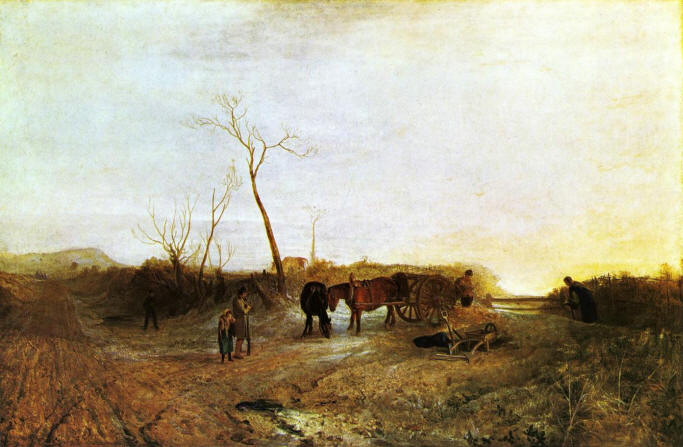
tate: Turner . Frosty Morning 1813. ''Turner was particularly fond of the painting shown above the fireplace, which is why it remained in his gallery rather than being sold to a collector. It records a scene he witnessed while travelling in Yorkshire, and is said to include his eldest daughter, Evelina (in blue) and his 'crop-eared bay' horse (pulling the cart). The painting was also much admired by contemporary and later critics. The Spectator saw in it 'the true tone of nature … imitated to perfection'. Years after Turner's death, Claude Monet saw it and declared it had been painted with 'wide-open eyes'.''
This was always true of Turner, no matter what sops he threw to the public by tying literary or topical references to exhibited pictures. He began composing verses of his own for this purpose, and in 1812 there appeared the first quotation from a poem with the cheerless title ”Fallacies of Hope” ; supposedly a work of epic length that Turner dabbled with over the years but a work that was never seen. The quoted lines were probably written for each occasion, and were quite embarrassingly ill-written. Turner’s thin acquaintance with humanistic learning has been regarded as a disadvantage accounting for the feeble classicism of his mythological subjects , but more perceptively it has been recognized as an advantage that gave his originality full play.
But none of this tells us much about Turner’s personality. For a man so famous, he managed to keep his private life private to a degree that has left him indecipherable. He wrote almost no letters and never went out in society. Did he have froends amonfg the sailors and fisherman and woman of the ports where he went to sketch? He used to hire small fishing boats to take him out in rough weather and once had himself lashed to the mast for four hours to observe the natural effects of a snow
m , wondering all the while, he admitted later, whether he would survive the experience.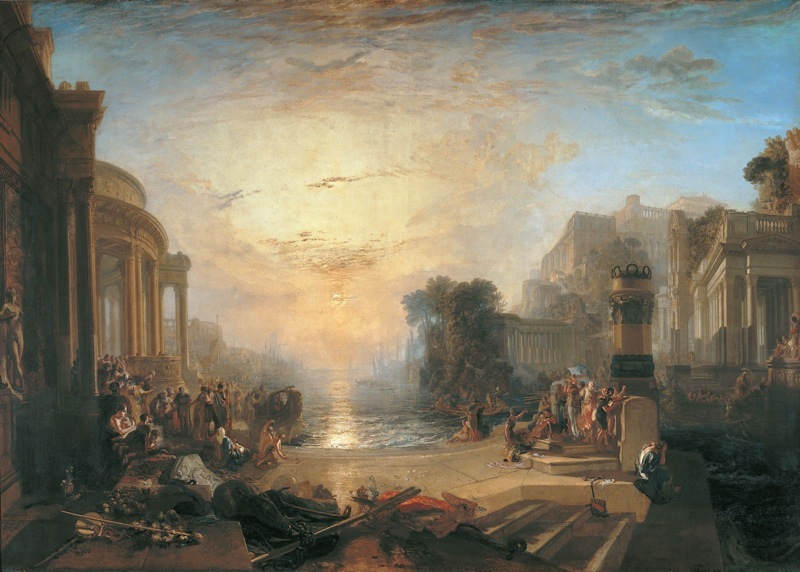
Tate. Turner. Decline of the Carthaginian Empire,1817,''This painting is shown in the centre of the long wall opposite the fireplace, the focal point of a series of five grand, tragic subjects. The fall of the once great city of Carthage is symbolised by the setting sun; the full title of the painting describes how the 'enervated' Carthaginians, desperate for peace, surrendered their arms and their children to their enemy, Rome. Turner saw the rise and fall of great empires as a historical inevitability, recently confirmed by the fall of Napoleon, but which also threatened the current supremacy of the British empire. The pair to this painting, Dido Building Carthage, is shown on the end wall of Turner's gallery. Today the pair are separated: Dido Building Carthage hangs in the National Gallery, while this painting is on display at Tate Britain.''
”With opportunity and encouragement, if the pages of Virgil were splayed before a curious youth, it matters not if the receptive mind is installed at day school New Brentford as was Turner, or Eton in the shadow of Windsor Castle. Although it is impossible to ascertain at this point, but Turner might even have been dyslexic; he was certainly a visual learner, which is often an indicator of this state. Regardless of his outward manifestations and innermost riddles, according to Rev. S.A Swaine, one must nevertheless appreciate Turner for his humanity. And this of course can be instilled anywhere:
‘Turner was as merciful an angler as even the pious and humane father of the craft could have desired. He would impale the devoted worm ‘as tenderly as he loved him’”… and according to a regular fishing companion, “his success as an angler was great, although with the worst of tackle in the world. Every fish he caught he showed to me, and appealed to me to decide whether the size justified him to keep it for the table, or return it to the river; his hesitation was often most touching, and he always gave the prisoner at the bar the benefit of the doubt.”
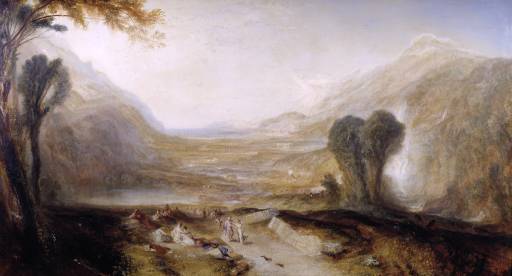
Turner. Story of Apollo and Daphne. Tate. ''This story comes from the Roman poet Ovid's Metamorphosis. The god Apollo had mocked Cupid, but has now fallen in love with Daphne. She runs away from him, and is saved by her father, the river Peneus, who turns her into a laurel on his banks. In the foreground Turner includes the dog chasing a hare, which Ovid compares to Apollo chasing Daphne.''
The friends he is known to have had, respected his privacy. By the time he was thirty-five, and perhaps much earlier, he was making annual visits to his friend Walter Fawkes of Farnley Hall, Yorkshire; visits that continued until Fawkes died in 1825. During this time Turner had formed a friendship with the earl of Egremont and had made some trips to his seat at Petworth. When Turner was fifty-four, his father died, in September, 1829, and he began at Petworth, the most intensely personal expression of his genius.
Turner’s work, in many senses, defies categorization in that it reflected a murky yet lucid understanding of the spirit world and the emergence of an order, apparently chaotic, out of nothing. As Christopher Hitchens says, ” religion has run out of justifications” , and Turner pictorially asked the question: ”But what is this mysterious human nature which is seen as the source of all our ills, and is alleged to be eternally unchangeable?” This is a profoundly philosophical question, to which not many would venture a reply, unless they were of a religious cast of mind, in which case they would say that God, in His wisdom, made us like that.
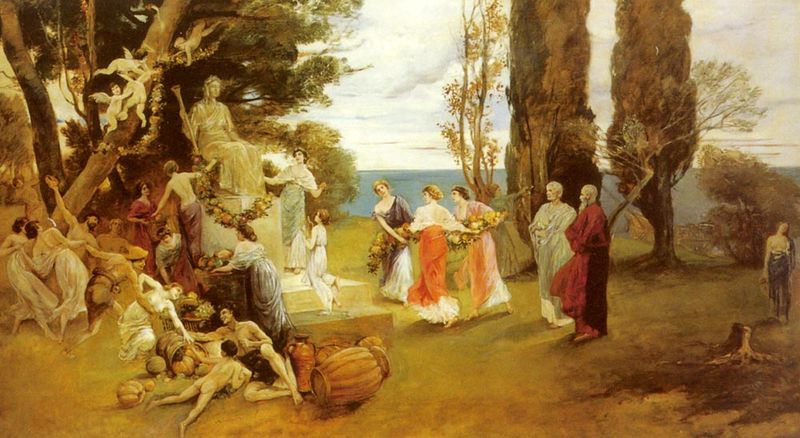
Friedrich August von Kaulbach. Aracadia. ''Of particular note is Et in Arcadia ego by Nicholas Poussin, which has become famous both in its own right and because of its (possible) connection with the gnostic histories of the Rosicrucians (see below). In 1502 Jacopo Sannazaro published his long poem Arcadia that fixed the Early Modern perception of Arcadia as a lost world of idyllic bliss, remembered in regretful dirges. In the 1590s Sir Philip Sidney circulated copies of his influential heroic romance poem The Countess of Pembroke's Arcadia establishing Arcadia as an icon of the Renaissance; although the story is plentifully supplied with shepherds and other pastoral figures, the central characters of the plot are all royalty visiting the countryside.''
Turner seemed to imply that why anyone should worship a Being that played such tricks on His creations is another matter. Most people usually succeed in muddling through life, until some great upheaval compels them to re-consider the kind of ideas and values they grew up with. The crisis of society forces them to question many things they took for granted. At such times, ideas which seemed remote suddenly become strikingly relevant, and Turner at the nascent beginning and then flowering of the Industrial Age and pure capitalism saw these cataclysmic circumstances unfold at the crossroads between his own yearning for a return to a lost Arcadia, restrained by a deep curiosity and ambiguous desire to embrace a new era that would add new impetus to existing emotions of agony, torment and passion; life as a tumor that alternated between the malignant and the benign.





 COMMENTS
COMMENTS